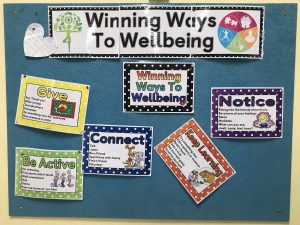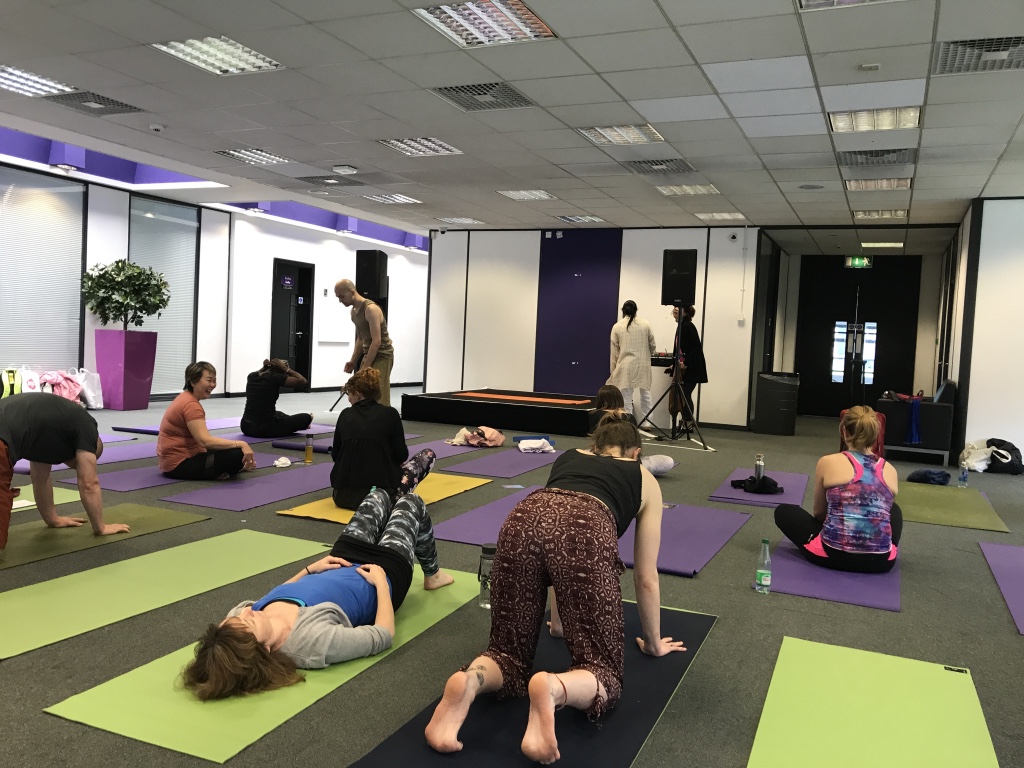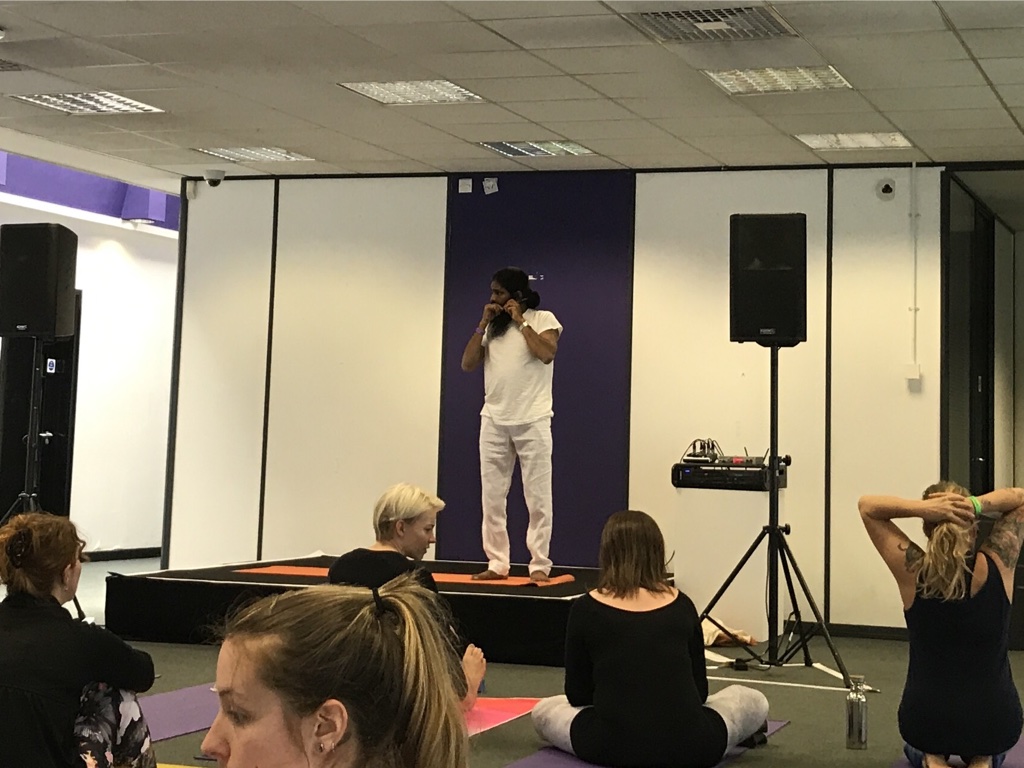I visited a primary school in Warwickshire recently and was pleased to see a display promoting wellbeing through 5 practical steps that are now promoted as basic steps to wellbeing all over the world. The ‘5 ways to wellbeing’ outline simple steps that we can all take to improve our wellbeing and are now advocated by the NHS in order to help people actively take control of their wellbeing. Starting small and building to a holistic approach to wellbeing can help us lessen or avoid more long-term conditions such as depression or anxiety that can effect physical and mental health for many years.
But what is wellbeing exactly? What are we trying to improve? Undoubtedly our mental health and states of mind, but wellbeing is a whole of life experience. An improvement in our overall quality of life and experience through practical, active steps to increase our levels of enjoyment, self-worth, physical and mental health and interactions with others.
This sounds like a big challenge, right? Definitely. But luckily the 5 ways to wellbeing really do work and are a great start to improving wellbeing.
The 5 Ways to Wellbeing
- Connect – There is strong evidence that being around others (friends, family, social groups) not only increases our all-round wellbeing, but also increases our longevity. Talking is the best therapy. You don’t have to share everything with others; start small. Make a meaningful connection instead of living in the digital world all the time. When you ask someone how they are, actually listen and pay attention to the answer. Speak to a stranger or make conversation while waiting in a queue. Try car sharing with a colleague; they might even become a friend.
- Be active – We have all read the decades of evidence that shows being physically active improves our mental health…so why do we still doubt it? Because it’s not easy to get active and stay active. But it’s not hard either. There are small changes we can make on the way to becoming more active and improving wellbeing. Take the stairs instead of the lift. Take a class after work with colleagues or organise a new sporting activity for all work colleagues to try. Go for a walk at lunchtime. Get off the bus a stop earlier and walk to your destination. If you feel like more of a challenge, take up a regular class that is proven to aid concentration, inner peace and help sleep…yoga is the obvious.
- Take notice – The basics of mindfulness; notice your surroundings. Be present in the moment and just ‘be’ instead of always ‘doing’. The only moment that exists is right now, so try to pay more attention to what is really going on instead of living in your head thinking about what has already happened or what might happen. Being mindful increases our awareness and knowledge of the self. If we know what we spend our time thinking about, we can start to change our thought patterns for the better. Living mindfully is a difficult task for the novice, but we can all try small steps. Choose a mindfulness cue; a sound or sight that whenever you hear/see it reminds you to take 60 seconds to be mindful and notice what’s going on in the environment.
- Keep learning – Not only is the mind kept active, but there is the chance for social interaction, being mindful and being active all rolled into one here. Continued learning can enhance self-esteem, motivation and can help you to prioritise goals and your own happiness. This doesn’t have to be a formal class to count as learning. You can try learning a new word each day, try reading the news in a foreign language, listen to classical music, join a book club.
- Give – By giving to others we develop our compassion which in turn increases our compassion for ourselves. Engaging in acts of kindness helps us to gain perspective on our own internal struggles and gain an understanding of the greater good. Giving your time, expertise or just random acts of kindness to others can greatly increase your wellbeing and decrease your attachment to seeking happiness through material gain.
A challenge…
I challenge you to try the 5 Winning Ways to Wellbeing for one week and track how you feel in body and mind. Leave a comment below about your experiences and check back to see my review of a week of Winning Ways to Wellbeing.

Yoga Masterclass with Yogi Ashokananda
One of the great joys of yoga is that no two teachers are the same. It’s so exciting to experience new flows, styles of teaching and types of yoga to keep the love of yoga alive.
This was the first time I’d managed to book my first choice workshop at the Om Yoga Show (show review can be found here). The session was 90 minutes long for the bargain price of £10. I expected the room to be an uncomfortable, overcrowded affair, but I was pleasantly surprised. Mats were well-spaced and there was enough room to spread out without getting too close to your neighbour (it’s just not very British to touch a stranger – especially a sweaty one).

The workshop was billed as a Himalayan Hatha Yoga series with energy to create freedom and lightness in the body. There were intense sun salutations with upward dog kept on the toes rather than the tops of the feet. Looking around, I could tell that everyone found this a change from their ‘norm’. There were people of all abilities in the class which is always great to see and be part of.
We were put through our paces using fast flows, arm balances, strength postures and some of the most intensive Kriya and pranayama I have ever experienced. The breath holds and transitions worked to cleanse the body, generate heat and still the mind. It was very tough! We worked through standing postures testing balance and strength. We added in fast arm movements to challenge concentration and work alongside pranayama. There were opportunities to try transitions from headstand to side crow and back and chair to flying pigeon to name a few. There were also challenging bound postures which I enjoy but really test the limits of patience and surrender. This was a full body and mind workout. We sweated…a lot.

Yogi Ashokananda was encouraging and warm. Although he moved through transitions quickly he was clear in his instruction – although firm when he spotted we were flagging. He added in asanas and movements I haven’t tried or heard of before (wagtail or cheetah pose anyone?) but they were intense. I really enjoy this physical form of yoga because pushing the limits of the body helps to control the mind. I really found this a transformational session and have since used some of Yogi Ashokananda’s practices in my classes, particularly how to move within postures rather than just the traditional holds. I also really enjoyed using pranayama and kriyas as an integrated practice while doing asanas rather than sitting down and doing them separately.
The only let down for me was the poor quality of yoga mats that were provided. They were slippy to the point of being dangerous in a class such as this where sweat was an inevitability. Holding downward dog was a feat of concentration and resolve. I recommend taking your own mat to the Om Yoga Show if you intend to do a workshop.
We finished with some chanting aloud (again not very British) which everyone engaged with (surprisingly). I’m not familiar with the verse we chanted but many were so it was great to be a part of it. I always enjoy some Om chanting at the end of a class though, it just really fills me with happiness.
Yogi Ashokananda prepared us well for the class by saying “corpse pose is called corpse pose for a reason. You shouldn’t do it unless you feel like you’re going to die. Five straight hours of yoga will make you feel like you’re going to die…you only get to do savasana then”. He stuck to his word…there was no savasana after the most intense 90 minutes of yoga I’ve ever done. But, he was right. I didn’t need it and I didn’t miss it.
Namaste

